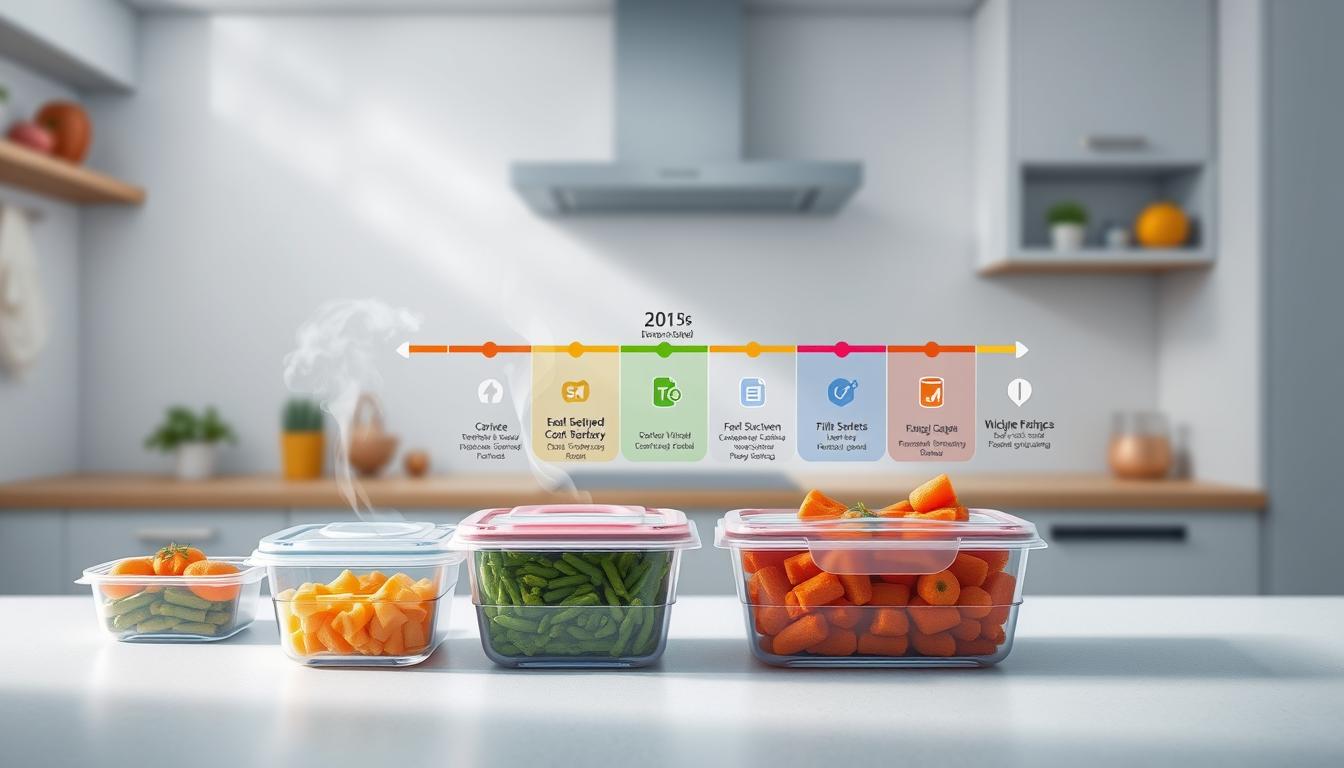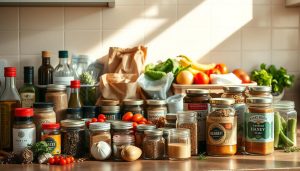Every year, foodborne illnesses send 128,000 Americans to the hospital – equivalent to filling a major sports arena twice over. Shockingly, 1 in 6 people contract these preventable illnesses annually, often from overlooked risks lurking in their kitchens.
The FDA warns that prepared dishes and opened perishables become unsafe after just 7 days. Yet millions risk their health daily by consuming items past their prime. This isn’t just about wasted groceries – it’s about avoiding severe health consequences that claim 3,000 lives yearly.
Proper meal storage isn’t guesswork. Federal agencies provide clear protocols to protect households while reducing food waste. By understanding expiration signals and storage timelines, you can confidently enjoy last night’s dinner without compromising safety.
Key Takeaways
- Federal guidelines limit refrigerated prepared meals to 7 days maximum
- Foodborne diseases cause 3,000 U.S. deaths annually – many preventable
- Visual/textural changes indicate dangerous bacterial growth
- Temperature control (below 40°F) dramatically extends safe consumption windows
- Labeling containers with dates prevents accidental risky consumption
Introduction to Leftover Safety

Your senses can’t detect many dangerous pathogens hiding in expired dishes. Foodborne bacteria like salmonella and E. coli often grow without changing appearance, odor, or flavor. This invisible threat makes strict food safety protocols essential for every kitchen.
Understanding the Basics of Food Safety
Bacteria multiply fastest between 40°F and 140°F – the “danger zone” where perishables become hazardous within hours. Refrigeration slows growth but doesn’t stop it completely. The CDC confirms norovirus causes 58% of U.S. food-related illnesses, often spreading through improperly handled meals.
Relying on taste tests or visual checks creates unnecessary risk. Even fresh-looking dishes can harbor enough pathogens to hospitalize vulnerable individuals. Always prioritize storage timelines over sensory evaluations.
The Importance of Safe Leftover Practices
One food poisoning episode can permanently damage organs in children, seniors, or immunocompromised people. Unlike spoiled milk you’d immediately discard, contaminated casseroles or deli meats rarely show obvious warning signs.
Consistent cooling and reheating habits break bacterial growth cycles. Labeling containers with preparation dates ensures you consume dishes before pathogens reach dangerous levels. These practices protect your household while reducing preventable health crises.
Factors Affecting Leftover Longevity
What determines whether your meal stays edible? Two critical elements shape food safety timelines: composition and environment. Protein-rich dishes behave differently than vegetable-based meals, while storage methods can accelerate or pause microbial activity.

Food Composition Matters
Protein and moisture create ideal breeding grounds for bacteria. Higher-risk foods like cooked meats and dairy products often require disposal within 3-4 days – well before the 7-day maximum. Soups and sauces with high water content spoil faster than dry items like bread.
Dense casseroles containing multiple ingredients pose unique challenges. Their layered structure creates micro-environments where pathogens can thrive undetected. Always prioritize consuming mixed dishes first.
Storage Environment Controls Safety
Your fridge becomes a food safety ally when maintained at 40°F or below. This temperature slows bacterial growth but doesn’t stop it. Leftovers left on counters enter the danger zone (40-140°F) where microbes double every 20 minutes.
Frozen foods remain safe indefinitely but lose quality over time. Use airtight containers to prevent freezer burn. For best texture, consume frozen meals within 2-3 months.
Storage containers influence outcomes too. Shallow containers cool dishes faster than deep pots, reducing time in the danger zone. Glass or BPA-free plastic prevents chemical leaching during storage.
How Long Are Leftovers Safe?
Federal food safety guidelines act as your shield against invisible threats. While expiration dates vary, research-backed timelines from the FDA and USDA offer clear boundaries for risk-free consumption.

Timeframes for Maximum Safety
The FDA Food Code sets a strict 7-day limit for opened or prepared perishable foods. This applies even if items look and smell normal. Most cooked dishes fall under a tighter 3-4 day window for optimal safety.
Reheating properly extends your safety net. When you heat meals to 165°F – verified with a food thermometer – you effectively reset the clock. This gives you another 3-4 days if stored at 40°F or below.
- Discard all refrigerated perishables after 7 days maximum
- Prioritize consuming cooked meals within 96 hours
- High-risk items like seafood require faster consumption
- Freezing pauses timelines but affects texture quality
These rules stem from decades of bacterial growth studies. Pathogens like Listeria can survive refrigeration and multiply silently. Following official timelines helps you stay ahead of contamination risks.
When in doubt, apply the golden rule: “When uncertain, throw it out.” No meal justifies jeopardizing your health. Proper labeling with preparation dates removes guesswork and keeps your kitchen crisis-free.
Safe Practices for Storing and Reheating Leftovers
Keeping meals safe requires more than just tossing them in the fridge. Time-sensitive actions and proper equipment use create multiple barriers against pathogens. Follow these evidence-based methods to protect your household from invisible threats.

Proper Refrigeration and Freezing Techniques
Move cooked food to the refrigerator within two hours – one hour in temperatures above 90°F. Divide large batches into shallow containers no deeper than 2 inches. This allows rapid cooling to prevent bacterial growth in warm spots.
| Storage Method | Temperature | Time Limit | Key Tip |
|---|---|---|---|
| Refrigeration | ≤40°F | 3-4 days | Use glass containers |
| Freezing | 0°F | 2-3 months | Remove excess air |
Check your refrigerator temperature weekly with an appliance thermometer. For freezing, wrap items tightly in moisture-proof materials to maintain quality while preventing freezer burn.
Effective Reheating Methods to Avoid Bacteria Growth
Always verify safe internal temperature using a food thermometer. Heat leftovers to 165°F – the critical threshold for destroying harmful organisms. Stir microwave-heated dishes halfway through cooking to eliminate cold zones.
For liquid-based items like soups, bring them to a rolling boil. This extra step ensures even heat distribution. Properly reheated food can be safely refrigerated again for up to four days if cooled correctly.
Remember: Each thorough reheating cycle resets the safety window. Combine these techniques with prompt storage to create multiple layers of protection against bacterial growth in your kitchen.
Identifying Leftover Quality and Signs of Spoilage
Your refrigerator hides secrets that could impact your health. While expiration dates offer guidance, food quality often declines before visible changes appear. Trusting your senses requires understanding subtle warning signs that demand immediate action.

Visual Cues, Odor Changes, and Texture Alterations
Mold appears in unexpected colors – white specks on bread, green fuzz on cheese, or pink patches on lunchmeat. These growths indicate compromised freshness, even if only visible in small areas. Discard entire containers when spotting any unusual formations.
Changes texture often reveal hidden dangers. Deli meats developing slimy coatings or casseroles becoming unnaturally mushy signal bacterial activity. Trust tactile observations – if it feels wrong, it likely is wrong.
Rancid odors serve as nature’s alarm system. “When in doubt, throw it out,” advises food safety expert Dr. Emily Carter. “Harmful pathogens produce distinct smells long before visible spoilage occurs.” Never taste-test questionable items – even small amounts can make sick.
Subtle discoloration often precedes obvious spoilage. Watch for browned edges on cooked vegetables or grayish tones in meat dishes. These quality indicators suggest chemical changes that reduce freshness and safety.
Remember: Some dangerous foods show no obvious signs. Adhere strictly to storage timelines, even when dishes appear normal. Your safest approach combines sensory checks with scheduled disposal dates for complete protection.
Preventing Foodborne Illness Through Proper Handling
Your kitchen habits directly determine your family’s vulnerability to invisible threats. While expiration dates and storage times matter, daily practices form the first line of defense against harmful pathogens.
Maintaining Cleanliness and Avoiding Cross-Contamination
Scrub hands with soap and water for 20 seconds before touching any food. This simple act removes up to 90% of surface bacteria, according to USDA research. Sanitize countertops and tools after preparing raw foods – especially after contact with poultry or meat.
Never rinse raw poultry in your sink. The CDC confirms this spreads dangerous bacteria across a 3-foot radius. Use separate cutting boards for produce and animal products – color-coding helps prevent mistakes.
Cooking, Cooling, and Temperature Control Tips
Cook meat to these minimum internal temperatures:
- 165°F for poultry
- 160°F for ground meats
- 145°F for whole cuts
Cool cooked food rapidly by dividing large portions into shallow containers. Stir soups every 15 minutes while refrigerating to accelerate temperature drop. Store raw foods below ready-to-eat items to prevent drips.
Always thaw frozen meat in the fridge – never on counters. For produce, rinse under cool water even when peeling. These layered strategies create multiple barriers against foodborne illness while maintaining food quality.
Incorporating Leftover Safety Into Your Daily Routine
Transforming kitchen habits requires more than knowledge—it demands consistent action. Start by labeling containers with preparation dates and discard times. This simple step helps track how long items remain safe to use food effectively.
Strategic Storage and Meal Rotation
Designate fridge zones to prevent cross-contamination. Keep ready-to-eat leftovers on upper shelves, while storing uncooked meats at the bottom. This layout protects against drips while keeping time-sensitive items visible.
Plan meals around expiration dates. Cooked dishes requiring faster consumption should appear earlier in your weekly menu. Freeze portions you won’t use food within four days to extend freshness.
Develop a “first in, first out” system. Place newer containers behind older ones to ensure you eat leftovers before they expire. Pair this with weekly fridge audits to identify items nearing their discard time.
Always keep mind temperature control during meal prep. Return dishes to refrigeration within 90 minutes during summer months. These organized practices turn safety protocols into effortless routines.



